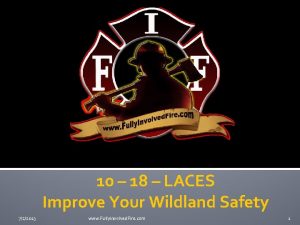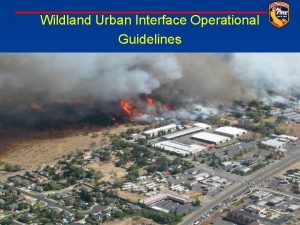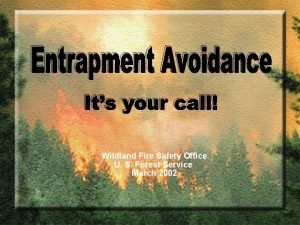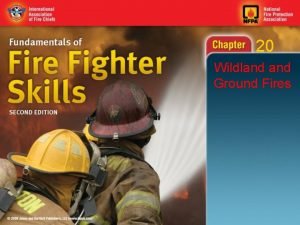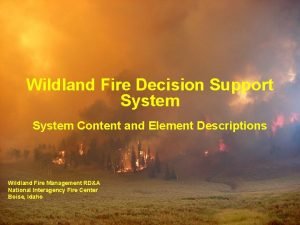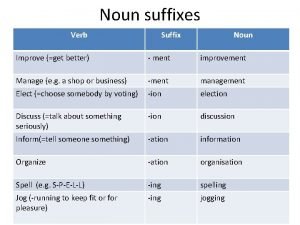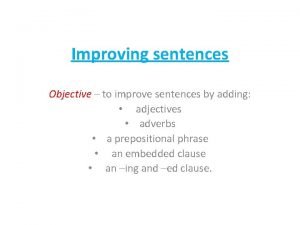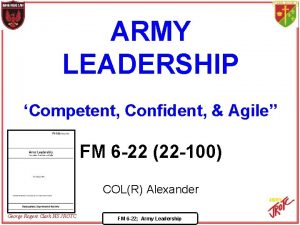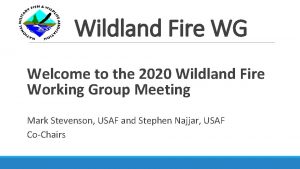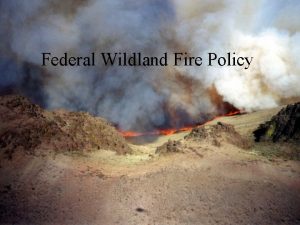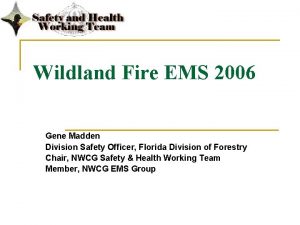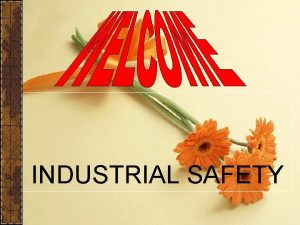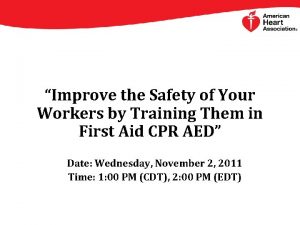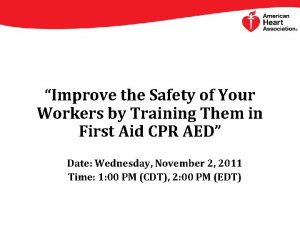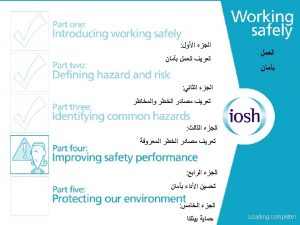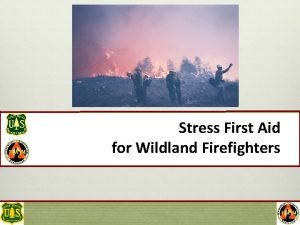10 18 LACES Improve Your Wildland Safety 722013




















































- Slides: 52

10 – 18 – LACES Improve Your Wildland Safety 7/2/2013 www. Fully. Involved. Fire. com 1

Presentation Training Objectives • Review wildland firefighter fatalities • Understand 10 wildland firefighting standing orders • Understand 18 wildland watchout situations • Review L. A. C. E. S. principle 7/2/2013 www. Fully. Involved. Fire. com 2

Images used under Fair Use Commons – Public Safety Training 19 Firefighters Killed – June 30 th, 2013 Nineteen members of the Granite Mountain Hotshots lost their lives battling the Yarnell Fire 7/2/2013 www. Fully. Involved. Fire. com 3

Images used under Fair Use Commons – Public Safety Training 19 Firefighters Killed – June 30 th, 2013 7/2/2013 www. Fully. Involved. Fire. com 4

19 Firefighters Killed – June 30 th, 2013 Granite Mountain Hot Shot Team Andrew Ashcraft, 29 Robert Caldwell, 23 Travis Carter, 31 Dustin Deford, 24 Christopher Mac. Kenzie, 30 Eric Marsh, 43 Grant Mc. Kee, 21 Sean Misner, 26 Scott Norris, 28 Wade Parker, 22 John Percin, 24 Anthony Rose, 23 Jesse Steed, 36 Joe Thurston, 32 Travis Turbyfill, 27 William Warneke, 25 Clayton Whitted, 28 Kevin Woyjeck, 21 Garret Zuppiger, 27 7/2/2013 www. Fully. Involved. Fire. com 5

19 Firefighters Killed – June 30 th, 2013 The 19 members of the Granite Mountain Hotshots lost on June 30 th were also structural firefighters. These 19 men were members of the Prescott AZ Fire Department. These 19 men represented over 20% of the PFD. 7/2/2013 www. Fully. Involved. Fire. com 6

Other Fatal Wildfires FIRE: YEAR: DEATHS: South Fork Fire - Idaho 2003 8 Firefighters Hayman Fire – Colorado 2002 5 Firefighters Storm King Mountain – CO 1994 14 Firefighters Loop Fire – California 1966 12 Firefighters Inaja Fire – California 1956 11 Firefighters These are just a few examples of large loss fires for firefighters. There are many more examples. Each underscores the importance of our training. 7/2/2013 www. Fully. Involved. Fire. com 7

Addressing Dangerous Mindsets: The large dangerous fires only happen out West. I’m an East Coast firefighter. That can’t happen to me. Those were all wildland firefighters. I am a structural firefighter. That can’t happen to me. 7/2/2013 www. Fully. Involved. Fire. com 8

Firefighter Fatalities at Wildfires: NIOSH Report Number: F 2011 -09 Volunteer fire fighter dies and 5 volunteer fire fighters are injured during wildland urban interface fire in Texas. 7/2/2013 www. Fully. Involved. Fire. com April 15 th, 2011 Attack 5 was overrun by the fire crossing CR 323 from east to west. . (Photo courtesy of the Texas Forest Service. ) 9

Firefighter Fatalities at Wildfires: NIOSH Report Number: F 2006 -10 On March 1, 2006, a volunteer fire fighter (the victim) was critically injured another volunteer fire fighter was seriously injured while fighting a wildland/urban interface fire in Oklahoma. 7/2/2013 www. Fully. Involved. Fire. com March 1, 2006 The fire burned over their position, destroying the grass truck, critically injuring the victim, and seriously injuring the fire fighter 10

Firefighter Fatalities at Wildfires: NIOSH Report Number: F 2003 -36 On October 29, 2003, a 38 -year-old male career fire fighter (the victim) was killed and a 48 -year-old male career Captain was severely injured when fire overran their position. 7/2/2013 October 29, 2003 The incident occurred during the protection of a residential structure during a wildland fire operation www. Fully. Involved. Fire. com 11

Firefighter Fatalities at Wildfires: NIOSH Report Number: 99 -F 14 Two Volunteer Fire Fighters Die While Fighting a Wildland Fire – Kentucky. The firefighters died trying to outrun the fire. 7/2/2013 April 06, 1999 As the fire grew in intensity and spot fires continued to break over the fire line, the two victims became separated from the rest of the crew. www. Fully. Involved. Fire. com 12

Addressing Dangerous Mindsets: Operating in the Urban Interface presents other unique challenges that can kill or injure firefighters. 7/2/2013 www. Fully. Involved. Fire. com 13

Firefighter Fatalities at Wildfires: NIOSH Report Number: F 2010 -15 Volunteer Fire Chief Killed When Rubber-Tracked Vehicle Overturns at Brush Fire – Washington 7/2/2013 June 23, 2010 The vehicle rolled at least 3 times before coming to rest on the driver’s side, facing west, pinning the Fire Chief beneath the vehicle’s canopy. www. Fully. Involved. Fire. com 14

Firefighter Fatalities at Wildfires: NIOSH Report Number: F 2008 -14 Volunteer Fire Chief and Fire Fighter Killed when their Engine plummeted from a Fire-Damaged Wooden Bridge Into a Dry Creek Bed – Colorado 7/2/2013 April 15, 2008 Key contributing factors identified in this investigation include: excessive speed for reduced visibility/smoke conditions www. Fully. Involved. Fire. com 15

Firefighter Fatalities at Wildfires: NIOSH Report Number: F 2000 -25 A volunteer fire fighter died and a second was seriously injured after fuel tank explosion in Iowa. 7/2/2013 April 07, 2000 The incident occurred at a grass fire that spread to structures. www. Fully. Involved. Fire. com 16

Firefighter Fatalities at Wildfires: NIOSH Report Number: 99 -F 46 Fire fighter dies after coming into contact with a downed power line at a wildfire Arkansas. 7/2/2013 November 3, 1999 The victim was stomping out embers in the smoldering brush when he was electrocuted by a downed power line. www. Fully. Involved. Fire. com 17

Addressing Dangerous Mindsets: Dangers to structural firefighters responding to and battling wildfires are real! These dangers include far more than the threat of burnover: Power Lines, Structural Collapse, Vehicle Accidents and more… 7/2/2013 www. Fully. Involved. Fire. com 18

Addressing Dangerous Mindsets: In Florida and other areas of high heat, heat stroke and heat exhaustion are very real threats. Especially if firefighters are wearing structural gear at wildland incidents. There are numerous LODD events involving heat stroke of firefighters at various types of incidents. This threat is very real for wildfires. 7/2/2013 www. Fully. Involved. Fire. com 19

Addressing Dangerous Mindsets: It can happen to structural firefighters! It can happen in any part of the country! It can happen to any of us! 7/2/2013 www. Fully. Involved. Fire. com 20

Protecting Ourselves and Being Safe 10 Standard Fire Orders 18 Watchout Situations L. A. C. E. S. 7/2/2013 www. Fully. Involved. Fire. com 21

10 Standard Fire Orders The original ten Standard Firefighting Orders were developed in 1957 by a task force. The Standard Firefighting Orders were based in part on the successful "General Orders" used by the United States Armed Forces. The Standard Firefighting Orders are organized in a deliberate and sequential way to be implemented systematically and applied to ALL fire situations. -US Forest Service 7/2/2013 www. Fully. Involved. Fire. com 22

10 Standard Fire Orders 1) Keep informed on fire weather conditions and forecasts. During your initial briefing fire weather should be addressed. If it is not, ASK! Remain alert of weather conditions and changes in forecast during fire operations. 7/2/2013 www. Fully. Involved. Fire. com 23

10 Standard Fire Orders 2) Know what your fire is doing at all times. Be aware of fire conditions. Remain alert to how the fire is burning and where it is burning. 7/2/2013 www. Fully. Involved. Fire. com 24

10 Standard Fire Orders 3) Base all actions on current and expected behavior of the fire. Recognize fuels and anticipate fire changes. Be prepared for weather changes that may change fire behavior. 7/2/2013 www. Fully. Involved. Fire. com 25

10 Standard Fire Orders 4) Identify escape routes and safety zones and make them known. During your crew briefing safe zones and escape routes should be identified. In the urban interface this could include previously burnt areas, large parking lots, bodies of water, and even swimming pools. If safe zones and escape routes are not identified, ASK! 7/2/2013 www. Fully. Involved. Fire. com 26

10 Standard Fire Orders 5) Post lookouts when there is possible danger. Lookouts can help recognize fire changes and alert crews. For structural crews operating in the urban interface buildings and other obstructions often prevent firefighters from seeing the fire. In addition, lookouts can help firefighters be alert for other hazards such as power lines. 7/2/2013 www. Fully. Involved. Fire. com 27

10 Standard Fire Orders 6) Be alert. Keep calm. Think clearly. Act decisively. It is critical to remain calm, identify threats, and respond accordingly. We must be thinking firefighters not heroes that blindly charge in. 7/2/2013 www. Fully. Involved. Fire. com 28

10 Standard Fire Orders 7) Maintain prompt communications with your forces, your supervisor, and adjoining forces. Communication is critical. Respond immediately to messages, speak clearly, and report changes or hazards you observe. 7/2/2013 www. Fully. Involved. Fire. com 29

10 Standard Fire Orders 8) Give clear instructions and insure they are understood. Ensure all messages are understood. When receiving messages, briefly repeat your orders back to confirm you correctly understood. 7/2/2013 www. Fully. Involved. Fire. com 30

10 Standard Fire Orders 9) Maintain control of your forces at all times. In structural firefighting we would not separate a two person crew to search two floors of a building. In wildfires, follow the same crew integrity rules. We leave the asphalt together. We return to the asphalt together. 7/2/2013 www. Fully. Involved. Fire. com 31

10 Standard Fire Orders 10) Fight fire aggressively, having provided for safety first. Remember to evaluate the risk vs. gain. PROVIDE FOR SAFETY ABOVE ALL ELSE!!! 7/2/2013 www. Fully. Involved. Fire. com 32

18 Watchouts Situations Shortly after the Standard Firefighting Orders were incorporated into firefighter training, the 18 Situations That Shout “Watch Out!” were developed. These 18 situations are more specific and cautionary than the Standard Fire Orders and describe situations that expand the 10 points of the Fire Orders. If firefighters follow the Standard Firefighting Orders and are alerted to the 18 Watch Out Situations, much of the risk of firefighting can be reduced. -US Forest Service 7/2/2013 www. Fully. Involved. Fire. com 33

18 Watchouts Situations 1 - Fire not scouted and sized up. 2 - In country not seen in daylight. 3 - Safety zones and escape routes not identified. 7/2/2013 www. Fully. Involved. Fire. com 34

18 Watchouts Situations 4 - Unfamiliar with weather and local factors influencing fire behavior. 5 - Uninformed on strategy, tactics, and hazards. 6 - Instructions and assignments not clear. 7/2/2013 www. Fully. Involved. Fire. com 35

18 Watchouts Situations 7 - No communication link with crewmembers/supervisors. 8 - Constructing line without safe anchor point. 9 - Building fireline downhill with fire below. 7/2/2013 www. Fully. Involved. Fire. com 36

18 Watchouts Situations 10 - Attempting frontal assault on fire. 11 - Unburned fuel between you and the fire. 12 - Cannot see main fire, not in contact with anyone who can. 7/2/2013 www. Fully. Involved. Fire. com 37

18 Watchouts Situations 13 - On a hillside where rolling material can ignite fuel below. 14 - Weather is getting hotter and drier. 15 - Wind increases and/or changes direction. 7/2/2013 www. Fully. Involved. Fire. com 38

18 Watchouts Situations 16 - Getting frequent spot fires across line. 17 - Terrain and fuels make escape to safety zones difficult. 18 - Taking a nap near the fire line. 7/2/2013 www. Fully. Involved. Fire. com 39

Together these are the 10 & 18 If firefighters follow the Standard Firefighting Orders and are alerted to the 18 Watch Out Situations, much of the risk of firefighting can be reduced. 7/2/2013 www. Fully. Involved. Fire. com 40

Together these are the 10 & 18 It is not easy to remember the 10 & 18. The 10 & 18 should be reviewed often. To help condense the 10 & 18 use LACES. 7/2/2013 www. Fully. Involved. Fire. com 41

L. A. C. E. S. LACES was established to consolidate down to five. The theory was the belief that under stressful circumstances human beings could only remember four to six key fundamental learned behaviors. 7/2/2013 www. Fully. Involved. Fire. com 42

L. A. C. E. S. L - LOOKOUTS A - ANCHOR POINTS C – COMMUNICATIONS E – ESCAPE ROUTES S – SAFETY ZONES 7/2/2013 www. Fully. Involved. Fire. com 43

L. A. C. E. S. L) LOOKOUTS: A competent and trusted person located in an advantageous position who has the responsibility of watching for potential fire problems and then relating the situation to their supervisor. In mountain terrain, that could be one person situated on an opposite slope and watching for an uphill run. Other lookout sources that can be used are: aircraft pilots, fire tower operators or possibly one person on a crew assigned the job of watching a specific hazard. 7/2/2013 www. Fully. Involved. Fire. com 44

L. A. C. E. S. A) ANCHOR POINTS An advantageous location, usually a barrier to fire spread, from which to start building a fire break or line. If done properly this will prohibit fire from establishing itself on the other side of an unsuspecting crew who could end up being surrounded with little chance for escape. An example of an anchor point could be a river, road, location without fuels or using a second crew to produce line in the opposite direction. 7/2/2013 www. Fully. Involved. Fire. com 45

L. A. C. E. S. C) Communications Can be provided in several forms: Face to Face, written Incident Action Plan, Briefing sessions, use of a Radio or Cell phone (if available). Crews are dependent on a variety of people to help ensure their safety because they will be concentrating on their job and may not be able to spot fire problems until too late. Information must be communicated to everyone concerned with the intent that it is known before an incident can occur. 7/2/2013 www. Fully. Involved. Fire. com 46

L. A. C. E. S. E) Escape Routes A pre-determined route that can be used by anyone in the event that fire begins an unexpected run that will jeopardize the safety of crews or anyone else on the fire line. The escape route will take everyone to another pre-determined location (safety zone). Some consideration when establishing the escape route: should be able to walk it, should be marked (flagging tape), should be timed, should be away from the head of the fire, should be known to all, should be scouted. 7/2/2013 www. Fully. Involved. Fire. com 47

L. A. C. E. S. S) Safety Zones Safety zones where a firefighter may find refuge from danger. Clean sites that are clear of vegetation (natural or man-made). Considerations when establishing a site are: How long will it take to get there? Is it large enough for everyone? Will fire behavior (intensity) adversely effect occupants? Are there any other hazards (snags, rolling rocks)? Does everyone know where they are? 7/2/2013 www. Fully. Involved. Fire. com 48

L. A. C. E. S. L - LOOKOUTS A - ANCHOR POINTS C – COMMUNICATIONS E – ESCAPE ROUTES S – SAFETY ZONES 7/2/2013 www. Fully. Involved. Fire. com 49

L. A. C. E. S. Remember LACES on every fire! 7/2/2013 www. Fully. Involved. Fire. com 50

Together these are the 10 & 18 LACES should be committed to memory and used at all fires. In addition the 10 & 18 should be reviewed often. 7/2/2013 www. Fully. Involved. Fire. com 51

Stay Safe This presentation was brought to you by: Fully Involved Fire, LLC www. Fully. Involved. Fire. com Professional Training for Fire Professionals 7/2/2013 www. Fully. Involved. Fire. com 52
 18 watchout situations for wildland firefighters
18 watchout situations for wildland firefighters Leader's intent
Leader's intent Trigger points wildland fire
Trigger points wildland fire Pincer attack wildland fire
Pincer attack wildland fire Nwcg ftp
Nwcg ftp Wfdss training
Wfdss training Lodi usd board meeting
Lodi usd board meeting Give us your hungry your tired your poor
Give us your hungry your tired your poor Ecdis safety settings
Ecdis safety settings Safety care 2 person stability hold
Safety care 2 person stability hold Personal safety vs process safety
Personal safety vs process safety Safety assessment for ind safety reporting
Safety assessment for ind safety reporting Basic safety (construction site safety orientation)
Basic safety (construction site safety orientation) Construction site safety orientation
Construction site safety orientation Decision making to improve marketing performance
Decision making to improve marketing performance Improve memory latency
Improve memory latency Pengertian interpersonal skill
Pengertian interpersonal skill Ways to improve urban infrastructure
Ways to improve urban infrastructure Profitability ratio
Profitability ratio Suffix of improve
Suffix of improve Suffix
Suffix How to improve psychomotor skills
How to improve psychomotor skills If you can't measure it, you can't improve it
If you can't measure it, you can't improve it Keep improve start stop methodology
Keep improve start stop methodology How to improve software economics
How to improve software economics Boring sentences to improve
Boring sentences to improve Invite fiilinin 3. hali
Invite fiilinin 3. hali Www.reachoutworld.org/amc
Www.reachoutworld.org/amc Financial statements and ratio analysis chapter 3
Financial statements and ratio analysis chapter 3 Leadership requirements model
Leadership requirements model How did the hongwu emperor improve life for the peasants?
How did the hongwu emperor improve life for the peasants? Joining together as a team to improve the quality
Joining together as a team to improve the quality Improve terminal server performance
Improve terminal server performance Difference between spirituality and religion
Difference between spirituality and religion Fokus secara kolektif terhadap pembelajaran murid
Fokus secara kolektif terhadap pembelajaran murid How to monitor and improve workplace operations
How to monitor and improve workplace operations How to improve yourself spiritually
How to improve yourself spiritually Improve website usability
Improve website usability Foreign synoynm
Foreign synoynm How did the panama canal improve trade
How did the panama canal improve trade Underarm forehand serve badminton
Underarm forehand serve badminton Action plan to improve english speaking skills
Action plan to improve english speaking skills White software industry to improve opensource
White software industry to improve opensource Define lactate inflection point
Define lactate inflection point Wckcs
Wckcs How did pasteur settle the spontaneous generation argument
How did pasteur settle the spontaneous generation argument Accurate cutting facilitates sewing and improve garment
Accurate cutting facilitates sewing and improve garment Cash flow forecast business studies
Cash flow forecast business studies Asset data to improve cmdbs and it systems
Asset data to improve cmdbs and it systems Government can sometimes improve market outcomes examples
Government can sometimes improve market outcomes examples Escore padua
Escore padua Dmaic charter
Dmaic charter Cash flow options
Cash flow options
